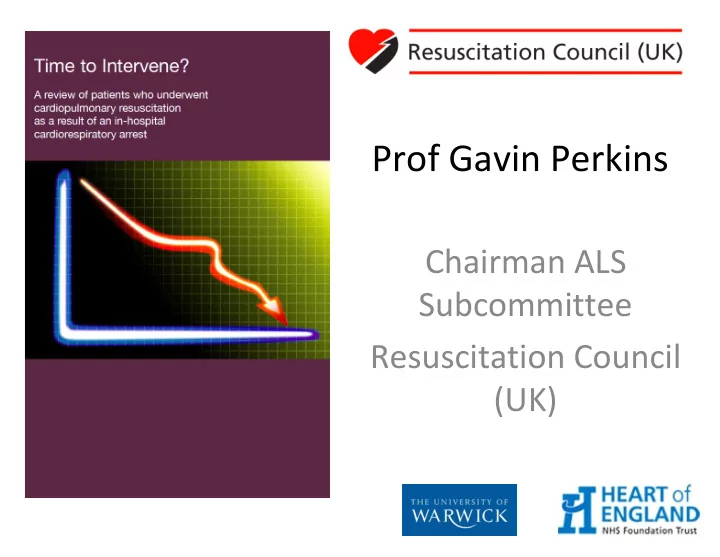

Prof Gavin Perkins Chairman ALS Subcommittee Resuscitation Council (UK)
• Charitable organisation • Founded 1981 • Focus – Policy document – Clinical guidelines – Training – Research
Chain of survival
Key messages Resuscitation Council (UK) perspective • Cardiac arrest prevention • CPR process – Airway – Defibrillation • Post resuscitation care • Decisions relating to CPR
Key messages Resuscitation Council (UK) perspective • Cardiac arrest prevention • CPR process – Airway – Defibrillation • Post resuscitation care • Decisions relating to CPR
Airway management Complex skill Often inadequate ventilation Stomach inflation Adverse effects on haemodynamics Simple to use Some airway protection Less stomach inflation Asynchronous compression / ventilation Definitive airway Complex skill Dangerous in untrained or inadequately trained hands Asynchronous compression / ventilation
Airway • Advisors – Problems with airway management in 17% of cases • Team leaders – Airway problems 1 in 20 resuscitation attempts • 25% of teams had no anaesthetist / intensivist
Delays
Airway management • BVM, pocket mask or SGA suitable for initial airway management • BVM is suboptimal for prolonged resuscitation • Resuscitation teams must – have identified person responsible for airway management who is trained in SGA or intubation – have clearly processes for escalation to someone with advanced airway skills
High ‐ score group Emergency call to team with critical care competencies and diagnostic skills. The team should include a medical practitioner skilled in the assessment of the critically ill patient, who possesses advanced airway management and resuscitation skills. There should be an immediate response.
• 1 hour workshop – Airway assessment – Basic airway interventions – Ventilation – Supraglottic airway devices
Resuscitation 2010 % defined adequate Defined as adequate
Use of I ‐ gel by non ‐ anaesthetists for in ‐ hospital cardiac arrest • 100 insertions: nurses (49); doctors (47); ROs (4) • 99% successful insertion – 82 on 1 st attempt • Audible leak/ventilation data in 61 – Chest rise, no leak 36 (59%) – Chest rise with leak 24 (39%) – No chest rise 1/61 (5%) • Compression + vent OK in 23/31 Larkin CB. Resuscitation 2012 Jun;83(6):e141
Initial rhythm: incidence and survival to hospital discharge Incidence %; NCAA NRCPR Survival (%) (n = 7,330) (n = 55,701) VF 12 (37) 16 (37) VT 4 (48) 7 (37) Asystole 29 (5) 36 (11) PEA 45 (9) 35 (12) Other 10 7 All rhythms (13.9) (16.4) Meaney PA. Crit Care Med 2010;38:101 ‐ 8 NCAA unpublished
Resuscitated patient characteristics Percentage of patients with substantial functional impairment • Median age 77 (IQR 68 ‐ 84) • 70% fatal condition (21% rapidly fatal)
DNACPR Decisions • CPR status infrequently considered • Incomplete compliance with DNACPR decisions • Communication poor • Senior staff rarely involved in discussions • Advisors felt DNACPR decisions should have been made in 85% of cases • Difficulty in differentiating between DNACPR and active treatment
DNACPR orders • Futility • Benefit / burdens • Patient refusal • Apply only to resuscitation decision
Variability in implementation DNACPR policy Hospital 1 2 3 4 5 6 7 8 9 10 11 12 13 14 15 16 17 1. Assessment of capacity 2. Discussion of decision for those with capacity 3. For those without capacity is it discussed with relatives 4. The validity of decision/time period 5. Is it a multi ‐ professional decision? Richard Field et al In preparation
Variability in implementation DNACPR policy
So what needs to change • Process – CPR decision all patients – CPR in context overall treatment • Education – Staff – Patients – Families • Engagement • Quality improvement • Research
Conclusion • Vital reading • Wake up call • Policy to practice • DNACPR http://www.resus.org.uk/pages/ncepodst.pdf
Recommend
More recommend